Descending Modal Transition Dynamics in a Large Eddy Simulation of a Rotating Detonation Rocket Engine
Abstract
:1. Introduction
1.1. RDRE Overview
1.2. Background
1.3. Research Focus
2. Methodology
2.1. Numerical Solver Overview
2.2. Grid and Chemical Mechanism Comparisons
2.3. RDRE Geometry and Numerical Setup
2.4. Detonation Surface Plots
2.5. 3D Data Extraction
3. Results
3.1. Numerical Validation—Experimental Comparison
3.2. 3D Chamber Data
3.3. Unwrapped Chamber Data and Pressure Disturbances
4. Analysis
4.1. Detonation Wave Trajectories
4.2. Detonation Wave Dynamics
4.3. Upstream Regions
4.4. Wave Stability
5. Conclusions
Author Contributions
Funding
Institutional Review Board Statement
Informed Consent Statement
Data Availability Statement
Acknowledgments
Conflicts of Interest
References
- Lu, F.K.; Braun, E.M. Rotating Detonation Wave Propulsion: Experimental Challenges, Modeling, and Engine Concepts. J. Propuls. Power 2014, 30, 1125–1142. [Google Scholar] [CrossRef] [Green Version]
- Bykovskii, F.A.; Zhdan, S.A.; Vedernikov, E.F. Continuous Spin Detonations. J. Propuls. Power 2006, 22, 1204–1216. [Google Scholar] [CrossRef]
- Wolanski, P. Detonation Engines. J. KONES Powertrain Transp. 2011, 18, 515–521. [Google Scholar]
- Fotia, M.L.; Hoke, J.; Schauer, F. Performance of Rotating Detonation Engines for Air Breathing Applications, 1st ed.; Springer International Publishing: Cham, Switzerland, 2018; pp. 1–21. [Google Scholar] [CrossRef]
- Hishida, M.; Fujiwara, T.; Wolanski, P. Fundamentals of Rotating Detonations. Shock Waves 2009, 19, 1–10. [Google Scholar] [CrossRef]
- Gaillard, T.; Davidenko, D.; Dupoirieux, F. Numerical simulation of a Rotating Detonation with a realistic injector designed for separate supply of gaseous hydrogen and oxygen. Acta Astronaut. 2017, 141, 64–78. [Google Scholar] [CrossRef] [Green Version]
- Bennewitz, J.W.; Bigler, B.R.; Schumaker, S.A.; Hargus, W.A. Automated image processing method to quantify rotating detonation wave behavior. Rev. Sci. Instrum. 2019, 90, 065106. [Google Scholar] [CrossRef] [PubMed]
- Lietz, C.; Ross, M.; Desai, Y.; Hargus, W.A. Numerical investigation of operational performance in a methane-oxygen rotating detonation rocket engine. In Proceedings of the AIAA Scitech 2020 Forum, Orlando, FL, USA, 6–10 January 2020. [Google Scholar] [CrossRef]
- Batista, A.; Ross, M.; Lietz, C.; Hargus, W.A. Descending Modal Transition Study in a Rotating Detonation Rocket Engine. In Proceedings of the AIAA SciTech 2021 Forum, Virtual Event, 11–15 and 19–21 January 2021. [Google Scholar] [CrossRef]
- Suchocki, J.; Yu, S.T.; Hoke, J.; Naples, A.; Schauer, F.; Russo, R. Rotating Detonation Engine Operation. In Proceedings of the 50th AIAA Aerospace Sciences Meeting including the New Horizons Forum and Aerospace Exposition, Nashville, TN, USA, 9–12 January 2012. [Google Scholar] [CrossRef]
- Rankin, B.A.; Richardson, D.R.; Caswell, A.W.; Naples, A.G.; Hoke, J.L.; Schauer, F.R. Chemiluminescence imaging of an optically accessible non-premixed rotating detonation engine. Combust. Flame 2017, 176, 12–22. [Google Scholar] [CrossRef]
- Stechmann, D.P.; Sardeshmukh, S.; Heister, S.D.; Mikoshiba, K. Role of Ignition Delay in Rotating Detonation Engine Performance and Operability. J. Propuls. Power 2019, 35, 125–140. [Google Scholar] [CrossRef]
- Bennewitz, J.W.; Bigler, B.R.; Pilgram, J.J.; William, A.; Hargus, J. Modal Transitions in Rotating Detonation Rocket Engines. Int. J. Energ. Mater. Chem. Propuls. 2019, 18, 91–109. [Google Scholar] [CrossRef]
- Koch, J.; Kurosaka, M.; Knowlen, C.; Kutz, J.N. Mode-locked rotating detonation waves: Experiments and a model equation. Phys. Rev. E 2020, 101, 013106. [Google Scholar] [CrossRef] [PubMed] [Green Version]
- Anand, V.; George, A.S.; Driscoll, R.; Gutmark, E. Characterization of instabilities in a Rotating Detonation Combustor. Int. J. Hydrog. Energy 2015, 40, 16649–16659. [Google Scholar] [CrossRef]
- Batista, A.; Ross, M.; Lietz, C.; Hargus, W.A. Detonation Wave Interaction Classifications in a Rotating Detonation Rocket Engine. In Proceedings of the AIAA Propulsion and Energy 2020 Forum, Virtual Event, 24–28 August 2020. [Google Scholar] [CrossRef]
- Zhdan, S.A.; Bykovskii, F.A.; Vedernikov, E.F. Mathematical Modeling of a Rotating Detonation Wave in a Hydrogen-Oxygen Mixture. Combust. Explos. Shock Waves 2007, 43, 449–459. [Google Scholar] [CrossRef]
- Kim, W.W.; Menon, S. An unsteady incompressible Navier–Stokes solver for large eddy simulation of turbulent flows. Int. J. Numer. Methods Fluids 1999, 31, 983–1017. [Google Scholar] [CrossRef]
- Masquelet, M.; Menon, S.; Jin, Y.; Friedrich, R. Simulation of unsteady combustion in a LOX-GH2 fueled rocket engine. Aerosp. Sci. Technol. 2009, 13, 466–474. [Google Scholar] [CrossRef]
- Génin, F.; Menon, S. Studies of shock/turbulent shear layer interaction using Large-Eddy Simulation. Comput. Fluids 2010, 39, 800–819. [Google Scholar] [CrossRef]
- Masquelet, M.; Menon, S. Large-Eddy Simulation of Flame-Turbulence Interactions in a Shear Coaxial Injector. J. Propuls. Power 2010, 26, 924–935. [Google Scholar] [CrossRef]
- Srinivasan, S.; Ranjan, R.; Menon, S. Flame Dynamics During Combustion Instability in a High-Pressure, Shear-Coaxial Injector Combustor. Flow Turbul. Combust. 2014, 94, 237–262. [Google Scholar] [CrossRef]
- Gottiparthi, K.C.; Menon, S. A Study of Interaction of Clouds of Inert Particles with Detonation in Gases. Combust. Sci. Technol. 2012, 184, 406–433. [Google Scholar] [CrossRef]
- Yang, S.; Ranjan, R.; Yang, V.; Sun, W.; Menon, S. Sensitivity of predictions to chemical kinetics models in a temporally evolving turbulent non-premixed flame. Combust. Flame 2017, 183, 224–241. [Google Scholar] [CrossRef]
- Bennewitz, J.W.; Schumaker, S.A.; Lietz, C.F.; Kastengren, A.L. Scaling of Oxygen-Methane Reacting Coaxial Jets Using X-Ray Fluorescence to Measure Mixture Fraction. Proc. Combust. Inst. 2021, 38, 6365–6374. [Google Scholar] [CrossRef]
- Bigler, B.R.; Bennewitz, J.W.; Danczyk, S.A.; Hargus, W.A. Rotating Detonation Rocket Engine Operability Under Varied Pressure Drop Injection. J. Spacecraft Rockets 2020, 1–10. [Google Scholar] [CrossRef]
- Wang, H.; Xu, R.; Wang, K.; Bowman, C.T.; Hanson, R.K.; Davidson, D.F.; Brezinsky, K.; Egolfopoulos, F.N. A physics-based approach to modeling real-fuel combustion chemistry - I. Evidence from experiments, and thermodynamic, chemical kinetic and statistical considerations. Combust. Flame 2018, 193, 502–519. [Google Scholar] [CrossRef]
- Xu, R.; Wang, K.; Banerjee, S.; Shao, J.; Parise, T.; Zhu, Y.; Wang, S.; Movaghar, A.; Lee, D.J.; Zhao, R.; et al. A physics-based approach to modeling real-fuel combustion chemistry-II. Reaction kinetic models of jet and rocket fuels. Combust. Flame 2018, 193, 520–537. [Google Scholar] [CrossRef]
- Wilke, C.R. A Viscosity Equation for Gas Mixtures. J. Chem. Phys. 1950, 18, 517–519. [Google Scholar] [CrossRef]
- Kim, W.W.; Menon, S.; Mongia, H.C. Large-Eddy Simulation of a Gas Turbine Combustor Flow. Combust. Sci. Technol. 1999, 143, 25–62. [Google Scholar] [CrossRef]
- Lietz, C.; Schumaker, S.A.; Sankaran, V. Examination of detailed methane/oxygen kinetics in the context of detonation simulations. In Proceedings of the 11th U.S. National Combustion Meeting Organized by the Western States Section of the Combustion Institute, Pasadena, CA, USA, 24–27 March 2019. [Google Scholar]
- Smith, R.D.; Stanley, S.B. Experimental Investigation of Rotating Detonation Rocket Engines for Space Propulsion. J. Propuls. Power 2021, 37, 463–473. [Google Scholar] [CrossRef]
- Bigler, B.R.; Bennewitz, J.W.; Schumaker, S.A.; Danczyk, S.A.; Hargus, W.A. Injector Alignment Study for Variable Mixing in Rotating Detonation Rocket Engines. In Proceedings of the AIAA Scitech 2019 Forum, San Diego, CA, USA, 7–11 January 2019. [Google Scholar] [CrossRef]
- Schumaker, S.A.; Knisely, A.M.; Hoke, J.L.; Rein, K.D. Methane–oxygen detonation characteristics at elevated pre-detonation pressures. Proc. Combust. Inst. 2021, 38, 3623–3632. [Google Scholar] [CrossRef]
- Powers, J.M.; Paolucci, S. Accurate Spatial Resolution Estimates for Reactive Supersonic Flow with Detailed Chemistry. AIAA J. 2005, 43, 1088–1099. [Google Scholar] [CrossRef]
- Powers, J.M. Review of Multiscale Modeling of Detonation. J. Propuls. Power 2006, 22, 1217–1229. [Google Scholar] [CrossRef]
- Schwer, D.; Kailasanath, K. Fluid Dynamics of Rotating Detonation Engines with Hydrogen and Hydrocarbon Fuels. Proc. Combust. Inst. 2013, 34, 1991–1998. [Google Scholar] [CrossRef]
- Ross, M.; Lietz, C.; Desai, Y.; Hamilton, J.; Hargus, W. Investigation into the Impact of an Exit Constriction on Rotating Detonation Rocket Engines, Using Large Eddy Simulations; Technical Report AD1108842; Air Force Research Laboratory: Edwards, CA, USA, 2019. [Google Scholar]
- Pal, P.; Xu, C.; Kumar, G.; Drennan, S.A.; Rankin, B.A.; Som, S. Large-Eddy Simulation of Ethylene/Air Combustion in a Non-Premixed Rotating Detonation Engine. In Proceedings of the AIAA Propulsion and Energy 2020 Forum, Virtual Event, 24–28 August 2020. [Google Scholar] [CrossRef]
- Prakash, S.; Raman, V.; Lietz, C.; Hargus, W.; Schumaker, S. Numerical simulation of a methane-oxygen rotating detonation rocket engine. Proc. Combust. Inst. 2020. [Google Scholar] [CrossRef]
- Prakash, S.; Fiévet, R.; Raman, V.; Burr, J.; Yu, K.H. Analysis of the Detonation Wave Structure in a Linearized Rotating Detonation Engine. AIAA J. 2020, 58, 5063–5077. [Google Scholar] [CrossRef]
- Ahrens, J.; Geveci, B.; Law, C. 36—ParaView: An End-User Tool for Large-Data Visualization, 1st ed.; Elsevier Butterworth-Heinemann: Burlington, MA, USA, 2005; pp. 717–731. [Google Scholar] [CrossRef]
- Kaemming, T.A.; Fotia, M.; Hoke, J.; Schauer, F. Thermodynamic Modeling of a Rotating Detonation Engine Through a Reduced Order Approach. J. Propuls. Power 2017, 33, 1170–1178. [Google Scholar] [CrossRef]
- Subramanian, S.; Meadows, J. Novel Approach for Computational Modeling of a Non-Premixed Rotating Detonation Engine. J. Propuls. Power 2020, 36, 617–631. [Google Scholar] [CrossRef]
- Cocks, P.A.; Holley, A.T.; Rankin, B.A. High Fidelity Simulations of a Non-Premixed Rotating Detonation Engine. In Proceedings of the 54th AIAA Aerospace Sciences Meeting, San Diego, CA, USA, 4–8 January 2016. [Google Scholar] [CrossRef]
- Chacon, F.; Gamba, M. Study of Parasitic Combustion in an Optically Accessible Continuous Wave Rotating Detonation Engine. In Proceedings of the AIAA Scitech 2019 Forum, San Diego, CA, USA, 7–11 January 2019. [Google Scholar] [CrossRef]
- Bigler, B.R.; Bennewitz, J.W.; Danczyk, S.A.; Hargus, W.A. Global Performance Effects of Mode Transitions in a Rotating Detonation Rocket Engine. In Proceedings of the AIAA Propulsion and Energy 2020 Forum, Virtual Event, 24–28 August 2020. [Google Scholar] [CrossRef]
- Turns, S.R. An Introduction to Combustion: Concepts and Applications, 3rd ed.; McGraw-Hill Higher Education: Boston, MA, USA, 2012; pp. 616–618. [Google Scholar]
- Lee, J.H.S. The Detonation Phenomenon, 1st ed.; Cambridge University Press: Cambridge, NY, USA, 2008. [Google Scholar] [CrossRef]
- Gordon, S.; McBride, B.J. Computer Program for Calculation of Complex Chemical Equilibrium Compositions and Applications; Technical Report; National Aeronautics and Space Administration; Lewis Research Center: Cleveland, OH, USA, 1994. [Google Scholar]
- Fievisohn, R.T.; Yu, K.H. Steady-State Analysis of Rotating Detonation Engine Flowfields with the Method of Characteristics. J. Propuls. Power 2017, 33, 89–99. [Google Scholar] [CrossRef]
- Ross, M.; Lietz, C.; Desai, Y.; Hamilton, J.; Hargus, W.A. Constriction-Induced Counter-Propagating Behavior in RDREs. In Proceedings of the AIAA Propulsion and Energy 2020 Forum, Virtual Event, 24–28 August 2020. [Google Scholar] [CrossRef]
- Ng, H.D.; Botros, B.B.; Chao, J.; Yang, J.M.; Nikiforakis, N.; Lee, J.H.S. Head-on Collision of a Detonation with a Planar Shock Wave. Shock Waves 2006, 15, 341–352. [Google Scholar] [CrossRef]
- Kuznetsov, M.; Alekseev, V.I.; Dorofeev, S.B.; Matsukov, I.; Boccio, J.I. Detonation Propagation, Decay, and Reinitiation in Nonuniform Gaseous Mixtures. In Twenty-Seventh Symposium (International) on Combustion; Elsevier: Boulder, CO, USA, 1998; Volume 27, pp. 2241–2247. [Google Scholar] [CrossRef]
- Wolanski, P. Rotating Detonation Wave Stability. In Proceedings of the 23rd International Colloquium for Dynamics of Explosions and Reactive Systems, Irvine, CA, USA, 24–29 July 2011. [Google Scholar]


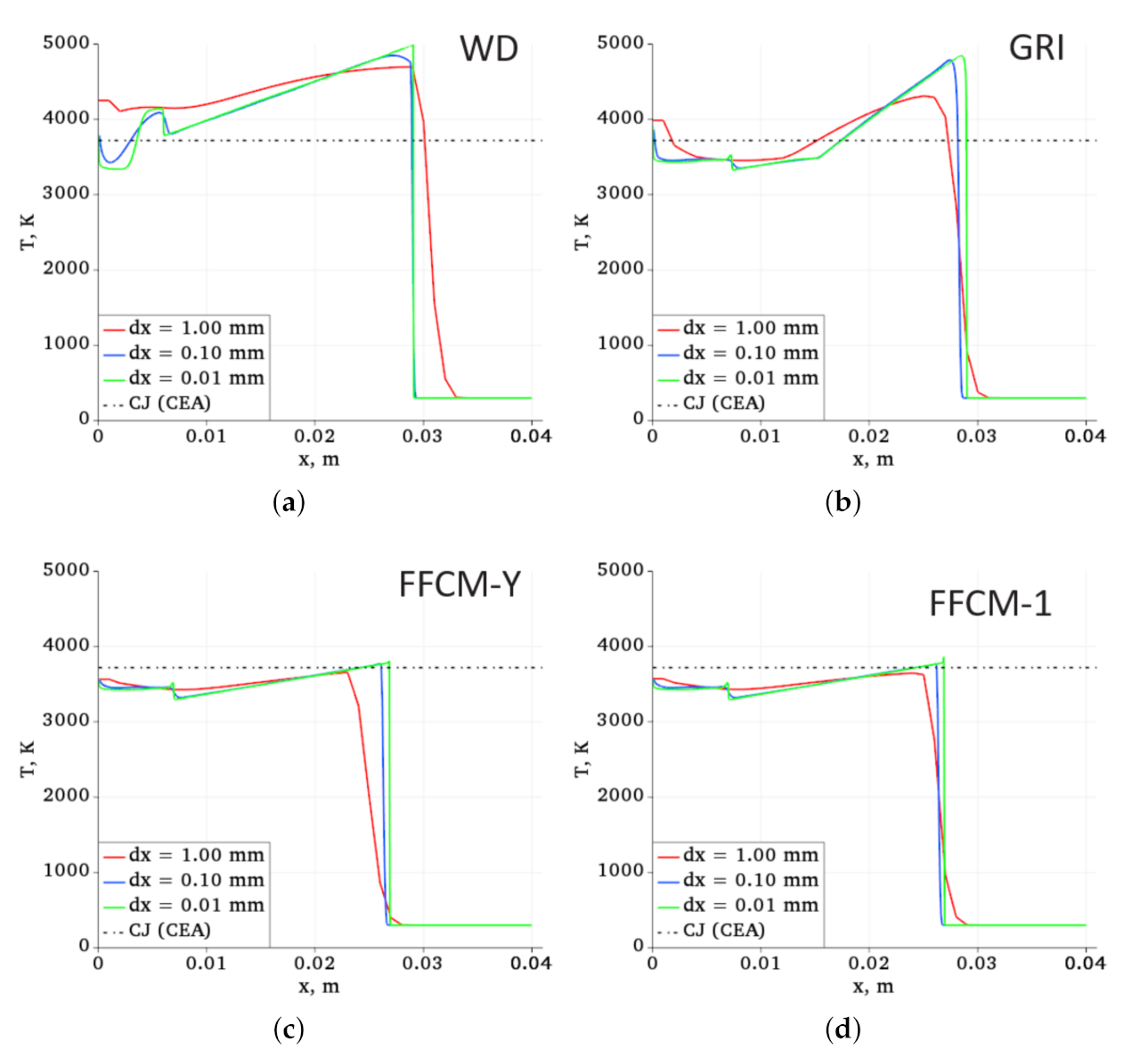

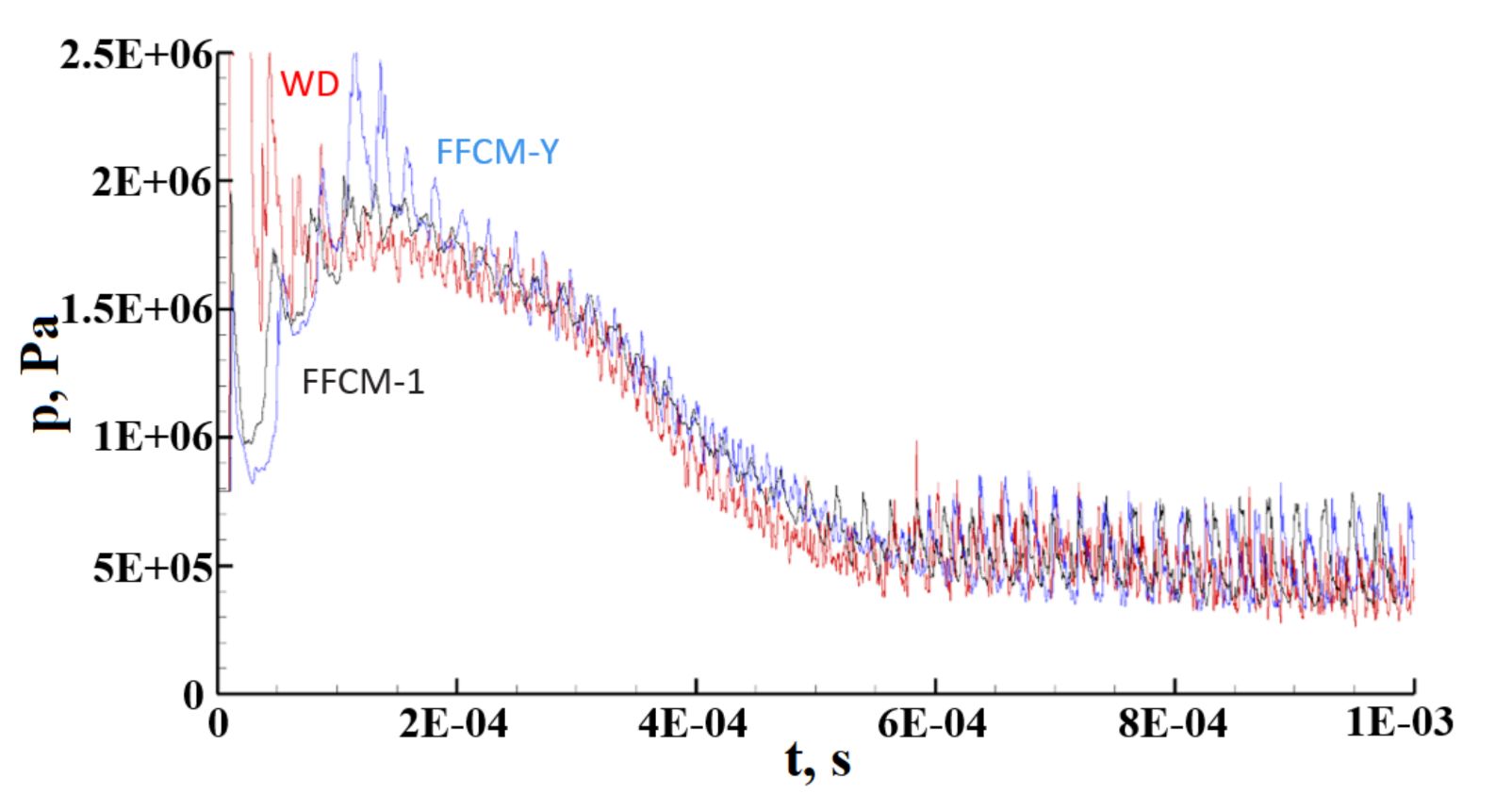
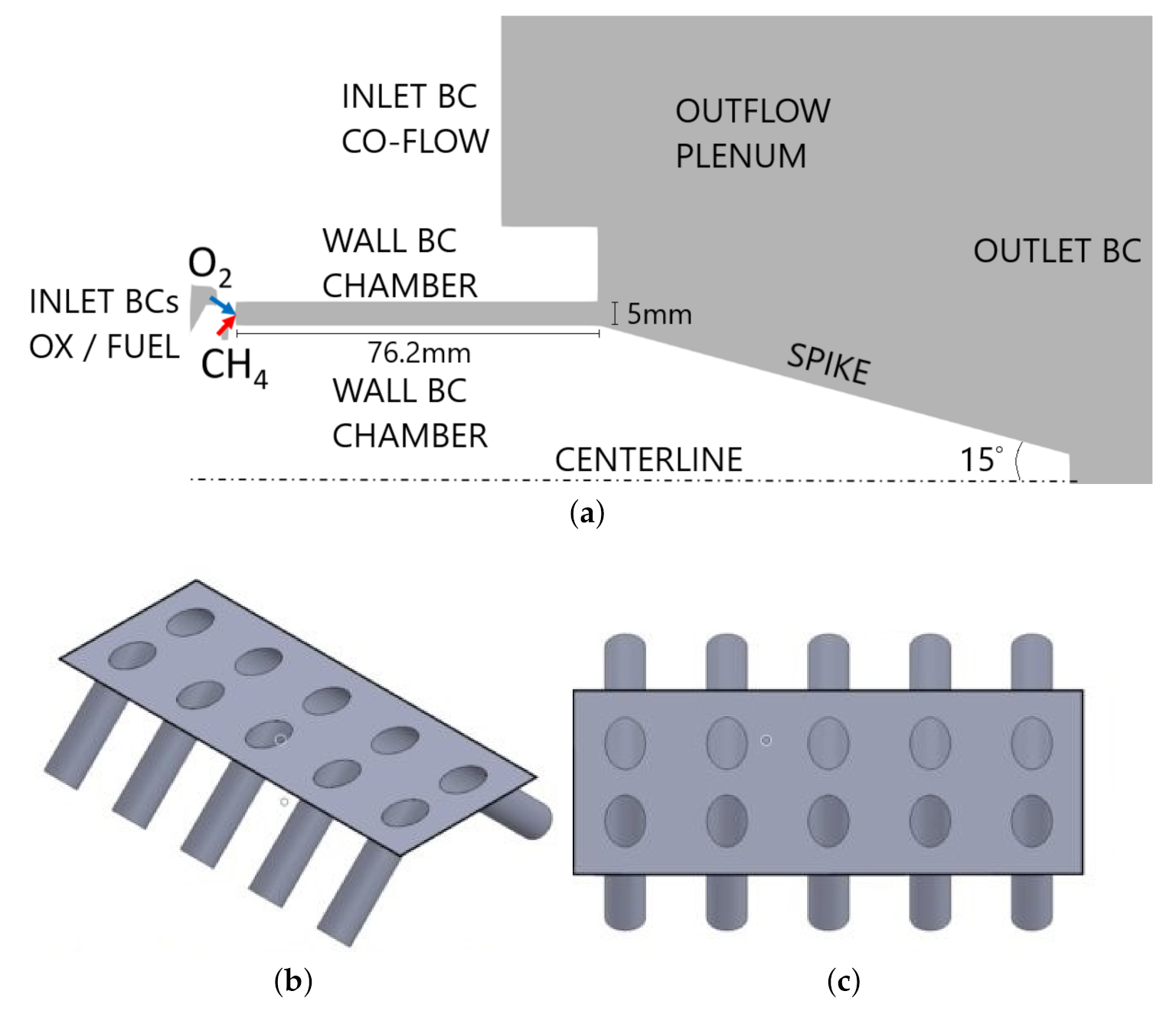
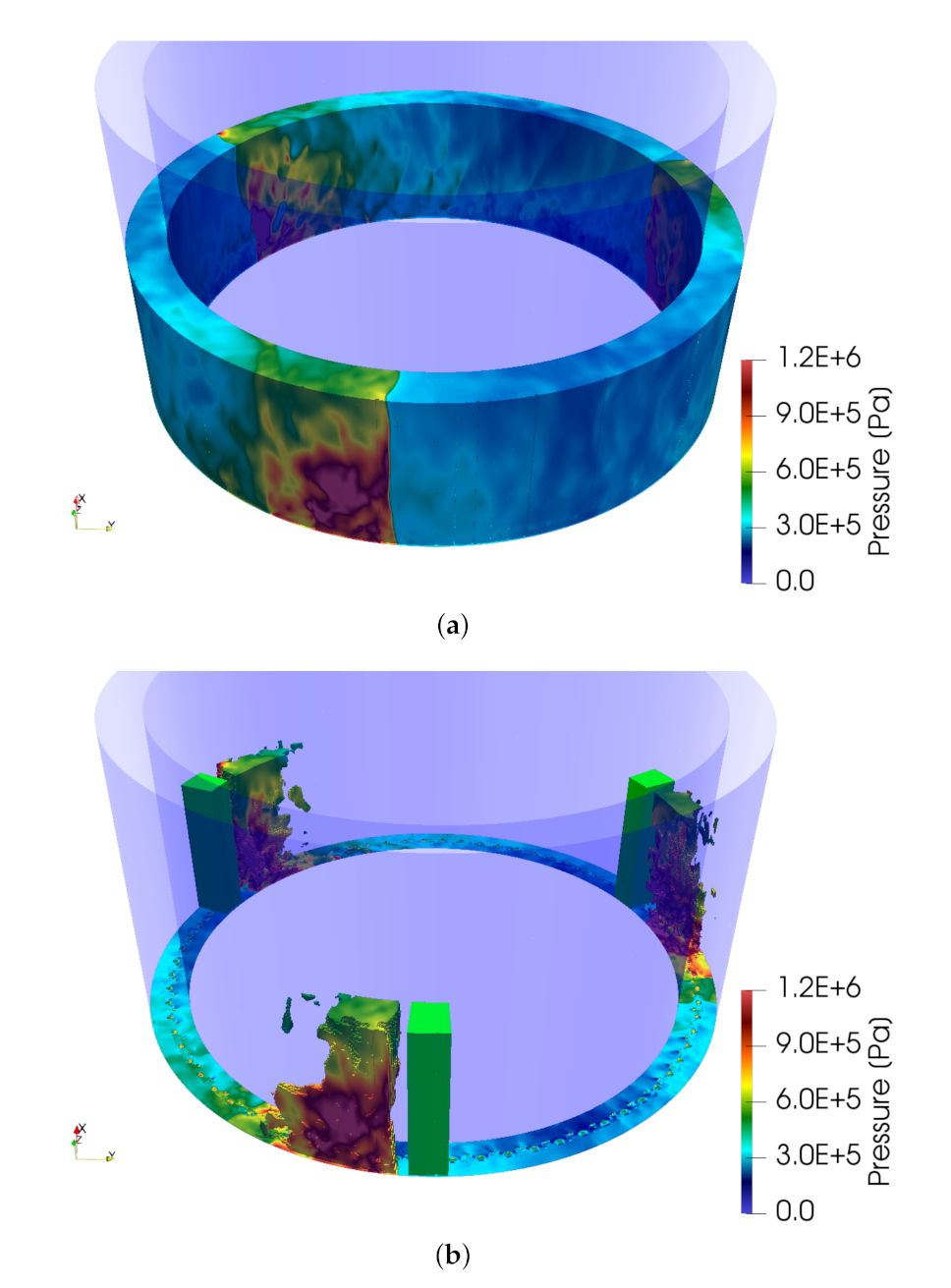






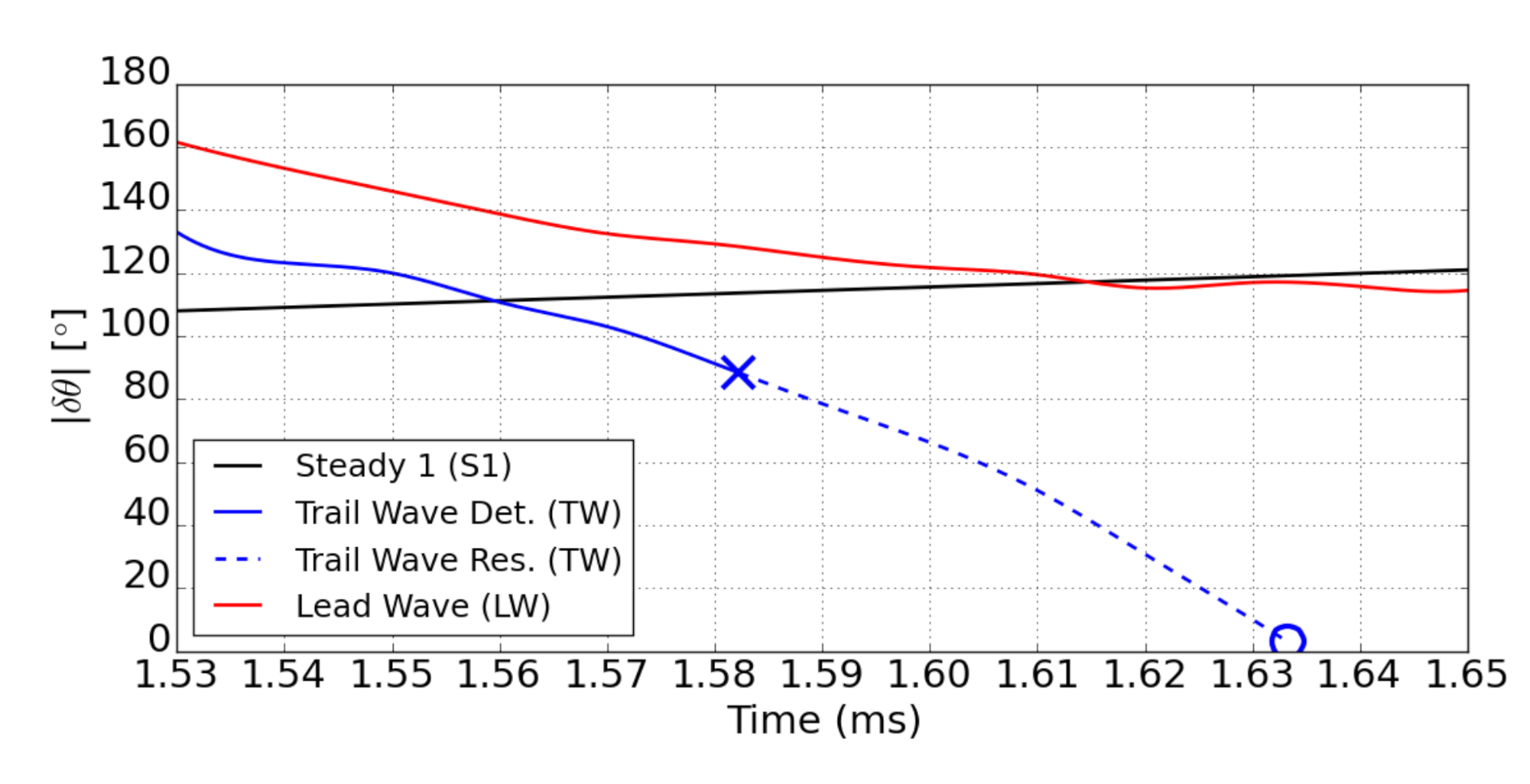
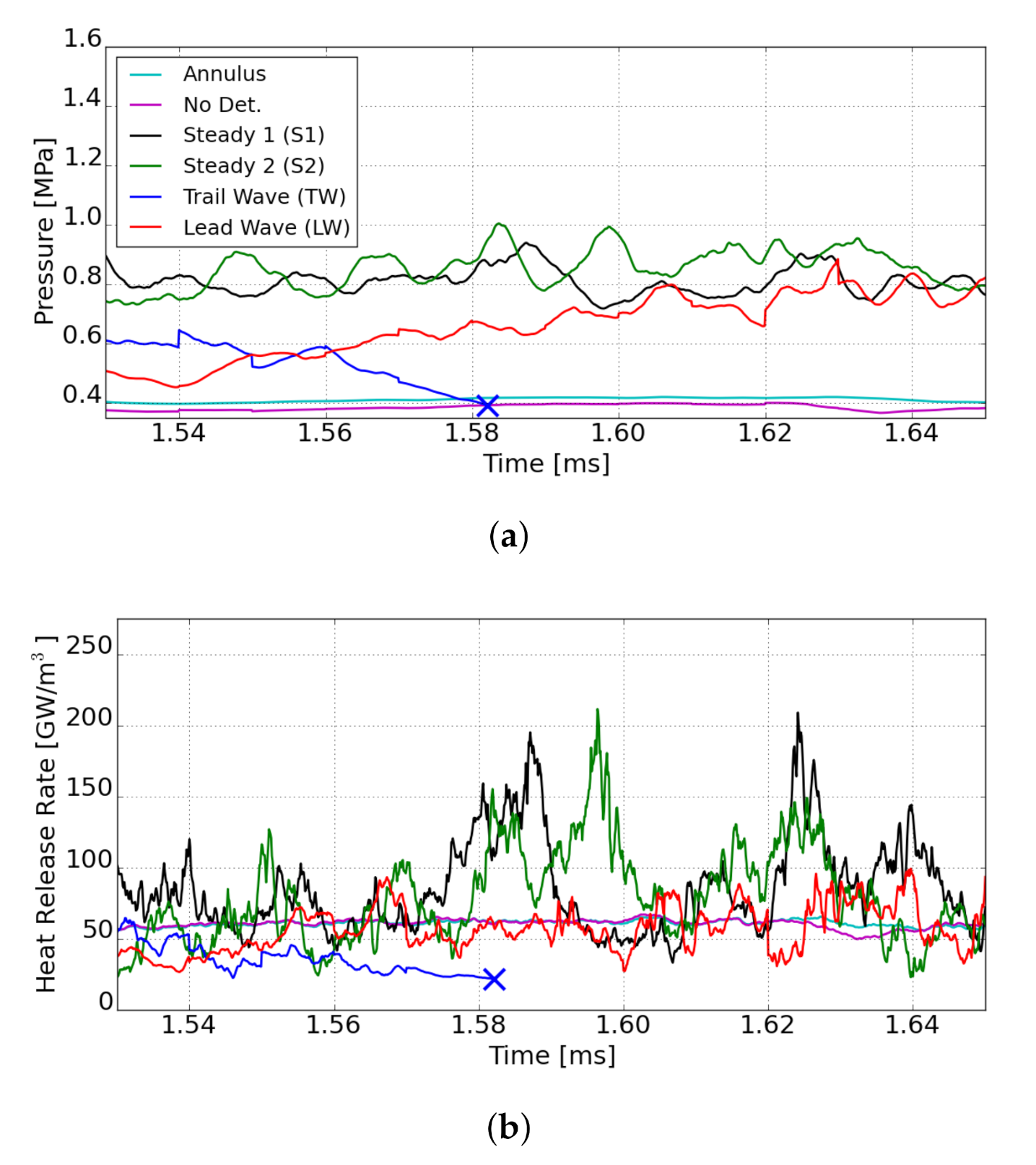

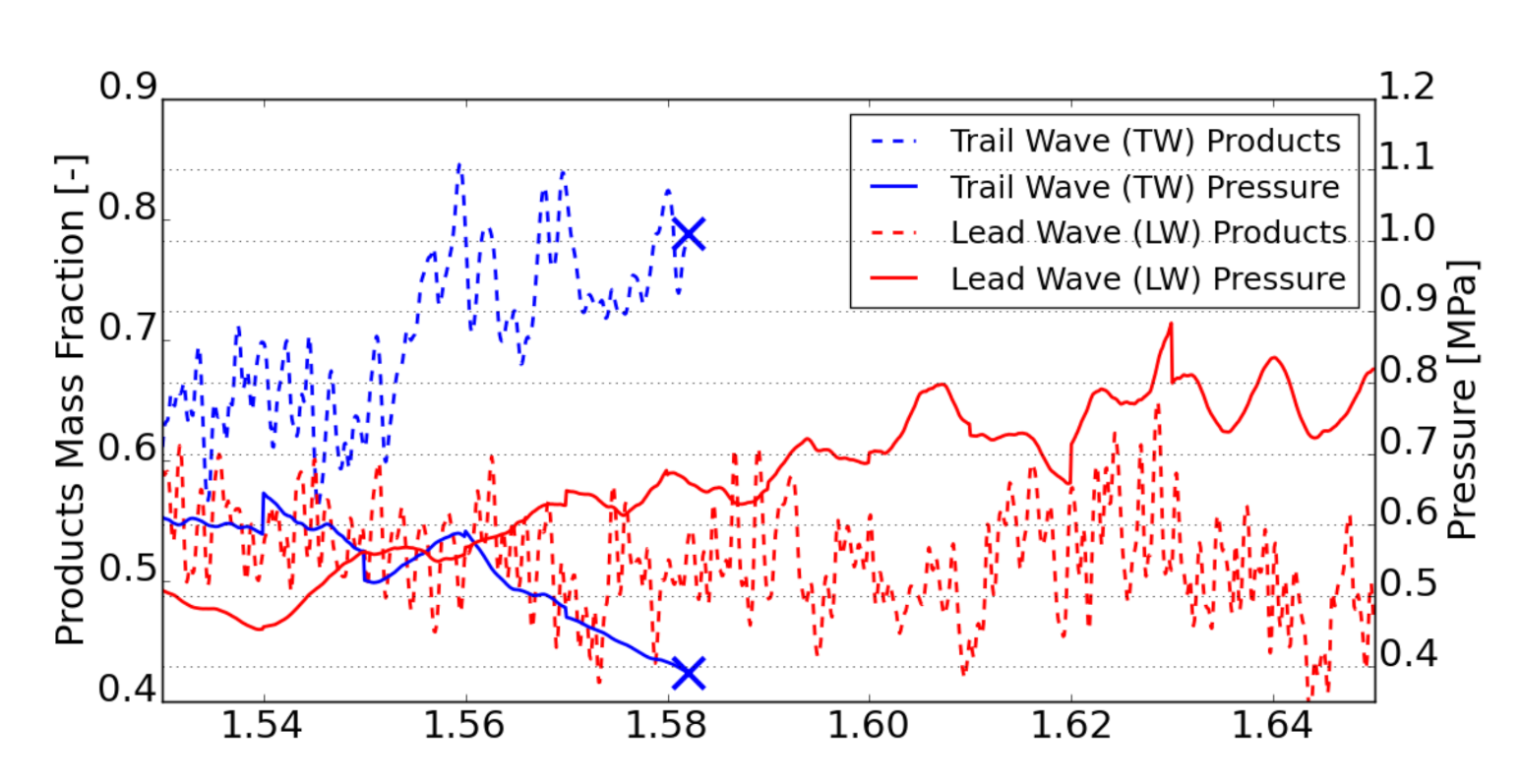
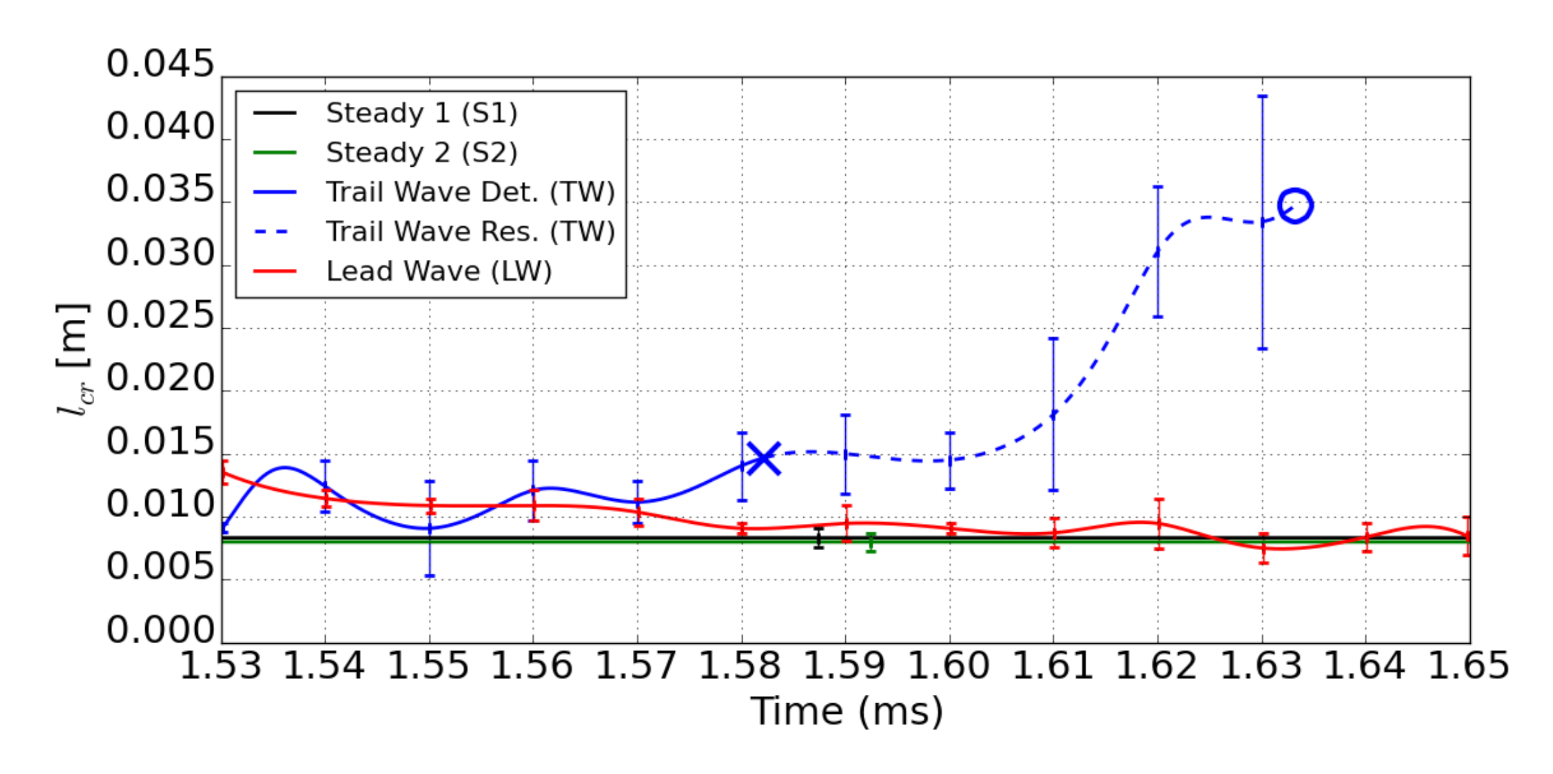
| [kg/s] | 0.267 |
| 1.15 | |
| T [K] | 300 |
| p [MPa] | 2.33 |
| p [MPa] | 2.07 |
| p [MPa] | 0.10 |
Publisher’s Note: MDPI stays neutral with regard to jurisdictional claims in published maps and institutional affiliations. |
© 2021 by the authors. Licensee MDPI, Basel, Switzerland. This article is an open access article distributed under the terms and conditions of the Creative Commons Attribution (CC BY) license (https://creativecommons.org/licenses/by/4.0/).
Share and Cite
Batista, A.; Ross, M.C.; Lietz, C.; Hargus, W.A., Jr. Descending Modal Transition Dynamics in a Large Eddy Simulation of a Rotating Detonation Rocket Engine. Energies 2021, 14, 3387. https://doi.org/10.3390/en14123387
Batista A, Ross MC, Lietz C, Hargus WA Jr. Descending Modal Transition Dynamics in a Large Eddy Simulation of a Rotating Detonation Rocket Engine. Energies. 2021; 14(12):3387. https://doi.org/10.3390/en14123387
Chicago/Turabian StyleBatista, Armani, Mathias C. Ross, Christopher Lietz, and William A. Hargus, Jr. 2021. "Descending Modal Transition Dynamics in a Large Eddy Simulation of a Rotating Detonation Rocket Engine" Energies 14, no. 12: 3387. https://doi.org/10.3390/en14123387






